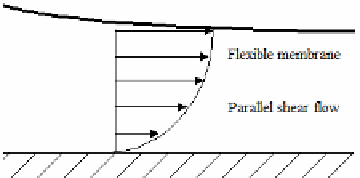Geology Reference
In-Depth Information
Direct evaluation using Equations 3.77 and 3.78 shows that
KE
= 1/4 g a
2
(3.86)
Comparing Equations 3.84 and 3.86, we find that
PE
=
KE
. Thus, the total
energy 1/2 g a
2
is
half
potential and
half
kinetic: this “equipartition of energy”
is characteristic of linear systems.
Let us now consider the rate of work dW/dt at a fixed “x,” performed by
the fluid at the left, on the fluid at the right,
0
dW/dt =
p
/ x dy
(3.87)
-
Use of Equations 3.70 and 3.78 shows that
dW/dt = 1/2 g a
2
( /k) sin
2
(kx- t) (3.88)
the integral of which over a period 2 / is 1/4 g a
2
. This is just one-half of
the total energy 1/2 g a
2
contained in one wavelength. Thus, the supply of
energy is sufficient only to advance an isolated wave group at a speed equal to
half the velocity of individual waves, in complete agreement with Equation 3.82.
3.4 Example 3-4. Fluid-Solid Interaction -
Waves on Elastic Membranes
We give another modal example containing free surface conditions,
namely, the stability of an inviscid shear flow
and
its interaction with an elastic
membrane. This requires coupled fluid-solid equations for the flow
eigenfunction and for the unknown membrane position. Unlike the previous
example, we will demonstrate how “bounds” on the eigenvalues can be obtained
for general flows without carrying out explicit integrations. We show how the
use of inequalities can be exploited, in order to produce general conclusions that
may not be apparent from specific examples.
Figure 3.4.
Fluid instability waves on elastic membrane.






















Search WWH ::

Custom Search